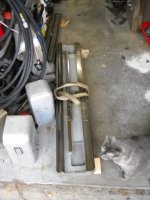smdubovsky
Hot Rolled
- Joined
- Apr 10, 2008
- Location
- MD
Looking to the folks who have run or repaired grinders for advice. I would normally ask the expert who originally did the work but he sadly is no longer with us
I have a KO Lee B360 tool and cutter grinder that had the ways reground and scraped a couple years back. I FINALLY got a little issue w/ the grit strip 'curtains' interfering out of the way and have gotten it back together. When I indicate in Z on the table it moves roughly 0.070"(!) along the table in the Y axis. I know that you regrind the top of a mag chuck when you re-mount it to the table. Im wondering more about regrinding the TABLE itself (technically, the carriage under the top swivel table.) Here is a similar pic of the carriage/top table I found on the web.
http://www.industrialsurplus.com/photos/049-499_4.jpg
Im running the indicator over the grounds ends of the carriage that the top table sits on (but indicating on the top table also shows the same error.) So the error is definitely in the carriage. The swivel top table contacts the lower table in three places. Both ends and the (off-center) 'island' that houses the swivel pin. It seems to me I must regrind these three points using the grinder itself. Being a little tool and cutter grinder, it has very little travel and can't do them all in one setup but can do each one individually. I can use my big camelback and surface plate to verify all three are reground to the same height.
The swivel table itself seems to mic parallel. All the problem is from the ways that were reground (the rear X way originally lost lube and took a beating - thus the rebuild.) So I'm not sure I would touch the swivel table itself as its very difficult to do it w/ the B360. If I get the carriage surfaces its sitting on level, then it should be level too. If I REALLY needed to touch the swivel top up, I'd take that to someone w/ a large enough grinder to do it proper in one setup.
Thoughts? 35thou of grinding (on average) is going to take a GOOD while even if they aren't big areas... The plates that indicate angle and such on the ends unbolt so I wont destroy them. Almost like it was designed to do what I think I have to do.

I have a KO Lee B360 tool and cutter grinder that had the ways reground and scraped a couple years back. I FINALLY got a little issue w/ the grit strip 'curtains' interfering out of the way and have gotten it back together. When I indicate in Z on the table it moves roughly 0.070"(!) along the table in the Y axis. I know that you regrind the top of a mag chuck when you re-mount it to the table. Im wondering more about regrinding the TABLE itself (technically, the carriage under the top swivel table.) Here is a similar pic of the carriage/top table I found on the web.
http://www.industrialsurplus.com/photos/049-499_4.jpg
Im running the indicator over the grounds ends of the carriage that the top table sits on (but indicating on the top table also shows the same error.) So the error is definitely in the carriage. The swivel top table contacts the lower table in three places. Both ends and the (off-center) 'island' that houses the swivel pin. It seems to me I must regrind these three points using the grinder itself. Being a little tool and cutter grinder, it has very little travel and can't do them all in one setup but can do each one individually. I can use my big camelback and surface plate to verify all three are reground to the same height.
The swivel table itself seems to mic parallel. All the problem is from the ways that were reground (the rear X way originally lost lube and took a beating - thus the rebuild.) So I'm not sure I would touch the swivel table itself as its very difficult to do it w/ the B360. If I get the carriage surfaces its sitting on level, then it should be level too. If I REALLY needed to touch the swivel top up, I'd take that to someone w/ a large enough grinder to do it proper in one setup.
Thoughts? 35thou of grinding (on average) is going to take a GOOD while even if they aren't big areas... The plates that indicate angle and such on the ends unbolt so I wont destroy them. Almost like it was designed to do what I think I have to do.




